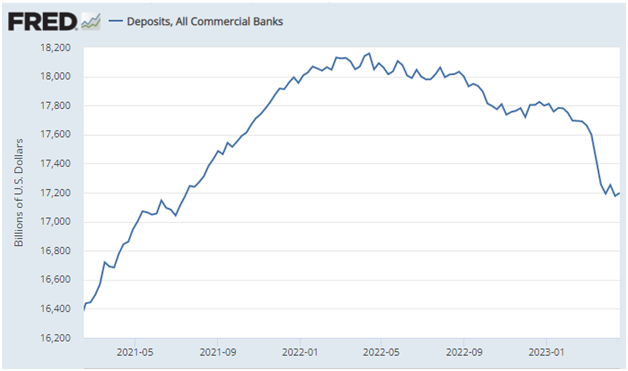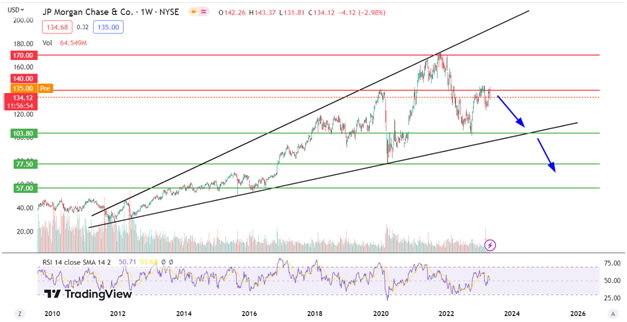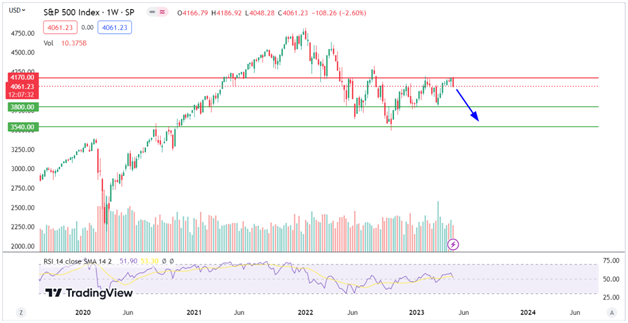On May 3, the Federal Reserve announced its 10th interest rate hike in just over a year, bringing the Fed funds rate to a target range of 5%-5.25% - the highest since August 2007. However, in the post-meeting statement, the phrase "some additional policy firming may be appropriate," which was included in its prior release, had been dropped. This suggests that the current tightening cycle may end, leaving the possibility for a pause in rate hikes.
While the markets had been eagerly awaiting the end of the rate hike cycle and looking for any sign of a monetary policy reversal, they took the dovish announcement of a possible end to the cycle negatively.
In this article, we explore why the Fed's statement is a bearish signal for risky assets and look at how the upcoming rise in US government debt will affect financial markets.
The Banking Crisis
When Silvergate Bank, Silicon Valley Bank, and Signature Bank (OTC:SBNY) went bankrupt in March, the Federal Reserve and the US Treasury promised to do "everything possible" so that the banking sector would not continue to collapse. Throughout April, US bank shares were sideways and even showed slight growth. However, at the beginning of May, the First Republic Bank (OTC:FRCB) declared bankruptcy.
This development disappointed investors, causing the shares of many banking sector companies to collapse.
A high key rate and tightening by US financial regulators of the conditions of issuing various loans (equivalent to a 1.5% increase in the country’s federal funds rate) led to fewer loan applications. This caused the companies’ revenues to decrease, reducing investor confidence in banks and driving them to withdraw their deposits from their accounts. Ultimately, the stock exchanges stopped trading in some securities altogether.

Source: Board of Governors of the Federal Reserve System (US)
At the FOMC press conference, Jerome Powell stated that as long as nothing unforeseen happens, the rate hikes are waning. Behind the ingenious linguistics of this statement lies a very specific, albeit fairly complex meaning. The head of the Fed is fully aware he will bear the liability for the banking crisis. Remember August 2021, when he said inflation was under control?
So what was Jerome Powell really telling us at the FOMC presser?
- The Fed understands that chaos in global finance may grow rapidly.
- The Fed is well aware of the depth of the problems in the banking sector. The same is true for commercial real estate.
- The Fed has no reason to say it overdid the rate increases since inflation has yet to be completely defeated. On the other hand, the Fed is aware that uncertainty is increasing, and that there is no obvious solution.
- The Fed can, of course, flood the banking system with liquidity. However, this may lead to complete loss of control over inflation.
- The situation is aggravated by a conflict over raising the public debt ceiling. While this is the province of the US Treasury and does not concern the Fed directly, it still ties the Fed’s hands.
- Powell is signaling that one way or another, it will be necessary to soften monetary policy. The only question is timing.
Raising the Government Debt Ceiling Will Not Solve the Problem
Historically, the public debt drama will drag on, with Democrats and Republicans negotiating until the final few hours before the cash on the US Treasury’s balance sheet ends. That is to say, an agreement will be reached at the end of May.
Some analysts believe this time will be an exception. However, even if the drama drags on past the deadline, it will not be for long, and will still result in an increase of the national debt ceiling. Those unwilling to make concessions will simply lose their votes in next year’s election. One way or another, whether shortly before or shortly after June 1, the debt ceiling will be raised by $1.5 trillion.
This is where the fun begins. Immediately after the government approves the raising of the national debt ceiling, the Fed will start to provide the US budget with liquidity, but not for the whole $1.5 trillion. The US Treasury will issue bonds for most of that amount to obtain liquidity. This will lead liquidity in the financial markets to decrease. The problems will appear with a lag of 1-2 months, so in June or July the market may fall due to low liquidity.
These difficulties will pile on top of the ongoing problems with the banks, the recession risks, and the struggles of the real estate market (high-interest rates on loans have reduced residential and commercial real estate transactions to almost nothing).
And let’s not forget the rapidly growing federal budget expenditures. The authorities have spent $3.15 trillion in fiscal year 2023 (started in October 2022), 13% more than the year before.
Based on the above, here’s what we might see two conclusions can be drawn:
- The US Treasury will borrow money in the markets. Thus, theoretically, bond yields may still rise.
- Reduced market liquidity could lead to a credit crunch, which, together with other factors, could lead to a drop in US indices.
Technical Outlook
The main beneficiary of economic uncertainty is gold, so no wonder, it jumped to 2050. If the price breaks through 2080 on the third attempt, it will move to 2300.
XAUUSD, Weekly timeframe

However, another retest of the upper channel’s border is also possible. In this case, you might consider gaining a position in the 1940.00 - 1950.00 range.
As we mentioned above, a further decrease in liquidity will hurt the shares of large banks.
JPM, Weekly timeframe

The price is moving inside the ascending wedge, usually a bearish pattern. Note that buyers experience problems bringing the price back to above 140.00. Due to the adverse economic situation, we expect a further decline toward the support trendline at 103.80. If that happens, the price will form a bearish “Head and Shoulders” pattern, with the major target at 57.00.
However, if the stock rises above 140.00 and closes a couple of weekly candles there, things will go in another direction.
S&P 500, Weekly timeframe

The S&P500 index will not be exempt from the upcoming market crash. The price has formed a massive resistance level at 4170.00. Currently, the index bounces off this level toward 3800.00. In the middle term, the price will most likely reach this support and break through it, sliding to 3540.00.
Summary
In his speech during the meeting on May 3, Jerome Powell admitted that the US economy is in a very difficult position. The banking crisis, persistently high inflation, the commercial real estate crisis, and the increase in budget spending will all put even more pressure on financial markets.
Moreover, the inverted yield curve between 2-year and 10-year bonds has historically been a signal for an approaching collapse of the markets. Now is a good time to think about closing long-term investment positions and ensuring the stability of your own portfolio’s liquidity.
***
FBS is an international brand present in over 150 countries. Independent companies united by the FBS brand are devoted to their clients and offer them opportunities to trade Margin FX and CFDs.
